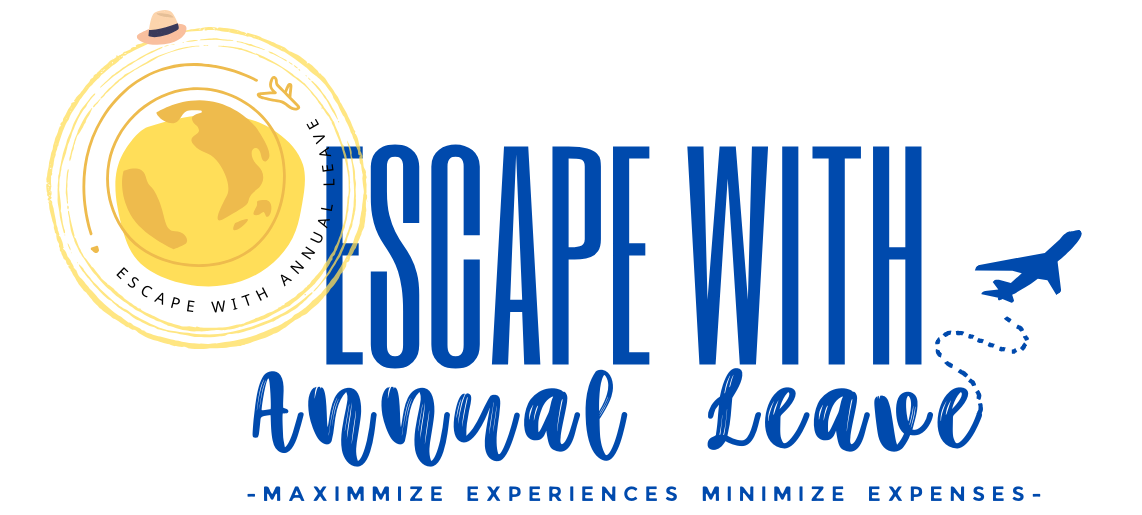Ultimate One Week Egypt Travel Plan – The Best Valued Route
EscapeWithAnnualLeave contains affiliate links. We may receive compensation at no extra cost to you. See our Disclosure Policy for more information.
Confused about egypt travel info? We have the best valued one-week Egypt travel plan for you. Our plan is one of the most concise routes for you to enjoy the best in Egypt. No matter whether you are traveling alone or with family.
Egypt is one of the most popular destinations in the world. Talking about Egypt you will naturally think of the Pyramids, the Sphinx, Pharaohs (ancient Egyptian King), and the mummies. Let alone the popularity brought by classic movies like Indiana Jones.
If you try to search online, you will find a whole bunch of pyramids, museums, temples, deserts, and even excursions.
All of these are claiming themselves as “must-sees”, boosting the FOMO to a max level. Worse you will find the price information and even currency information about Egypt confusing, let alone the notorious scamming (or tipping) everywhere in Egypt.
So despite the abundance of information, it is very hard to plan an Egypt adventure.
I have been through these and thus I want to share my one-week Egypt travel plan to help with your adventure too.
So let’s begin.

Why Should I Travel To Egypt?
Ancient Egypt has a rich and captivating history that spans over 3,000 years. The ancient Egyptian civilization started around 3100 BC to 332 BC. The remarkable era is also known as the Pharaonic Period with over 170 Pharaohs (Kings). The whole period is roughly divided into three periods namely the Old Kingdom (when the pyramids were built), the Middle Kingdom, and the New Kingdom.
You may ask Egypt isn’t the only place with thousands of years of history. This is true but it is probably the most well-reserved civilizations that you can still get into the 4000 + old Pharaoh’s tomb, seeing the clear hieroglyphic scripts on the temple walls and taking photos with the gigantic pyramids and the Sphinx.
Traveling around the world, there are always close substitutes for each type of experience. For example, you can visit nice Buddhist temples in China, Thailand, and Laos. You can have wildlife encounters in Countries like Maldives and South Africa. However, you can only find the grand periods, the ancient tombs, and temples with artistic hieroglyphics in Egypt. What’s more you can do it in a week !
Simply imagining yourself inside the pyramid which was built 4,500 years + ago, would be exciting enough for you to choose Egypt.
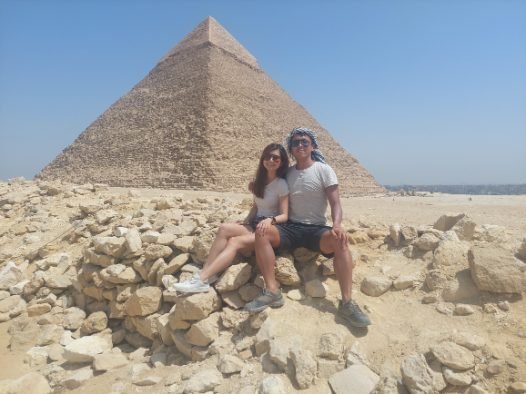
When is the best time to travel to Egypt?
The hottest time of the year for Egypt can go above 100°F (38°C), especially in the Northern desert area. So unlike other Countries. The peak season (i.e. October to April) is the best time to visit Egypt.
First, the temperature is relatively cooler. It helps a lot when you visit the great pyramids, Valley of Kings, and temples like Abu Simbel, given most of these are open-air with limited shelters. Yes, it is also the busiest tourist season with long holidays like Xmas and Easter and may drive up the price. However, the large crowd would make you feel safer in the locations and diverse attractions of the aggressive vendors and scammers. Yes, Egypt is also a Country notorious for tourist scamming.
Moreover, the holiday season is also the best for employees like us to structure a week-long vacation there. The price level in Egypt is very cheap (if not cheapest in the world). For example, three souvenir pyramid statues would cost you only USD 1 even at the tourist icons. So a slight price increase would not affect your budget that much.
Of course, you should consider booking your air ticket beforehand. If you want to want to avoid peak season September, October, and early March would also be a good choice.
Anyhow, you should avoid going there during summer i.e. from June to August.

How many days in Egypt travel?
As answered, our Egypt travel plan for one week shall suffice.
Why?
There are indeed a lot of landmarks in Egypt that probably could take months to explore. Well if you are an Egyptologist, people who specialize in the study of ancient Egyptian civilization, then you could spend years in Egypt.
Yet, if you are just like me a world-traveler who has limited time to get the most. Then, one week in Egypt would be sufficient.
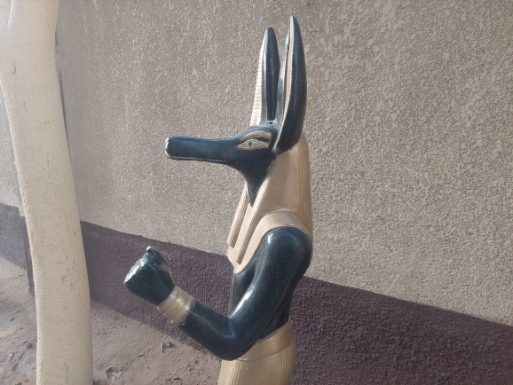
North or South?
Now let’s take a look at the major spots for travelling in Egypt. We can divide them into central, southern, and northern parts.
For the central part, it would be mainly Cairo and Giza. Cairo is the usual landing destination for international flight part and Giza (which is around 40 minutes Uber ride from Cairo airport) contains the must-see icons like The Great Pyramids and the Sphinx. The second important icons would include the Egyptian Museum, Khan el-Khalili Bazaar, and the oldest Pyramids near Sakkara(Memphis) and the Dahsur area. There are also items in Cairo such as different mosques or churches but that shall have less priority.
The Southern part includes the landmarks in Aswan and Luxor. The most famous items include the Abu Simbel temple (the second most famous icon in Egypt), the Valley of Kings (you can visit the tombs of Pharaohs built underground), and multiple ancient temples like Luxor, Karnak, and Philae Temples.
Other than the ancient landmarks, this is also the part where you can experience the cruise at the famous Nile River and a hot air balloon with a view of the Valley of Kings at Luxor (the balloon fee is a lot cheaper than that of Turkey).
The Nothern part is more about adventure experiences. It is famous for the city founded by Alexander the Great in 331 BCE. There are icons like the ancient library, the Citadel of Qaitbay, and the Lighthouse of Alexandria in the City. Other than that the Northern part is also famous for items like black-white desert, different Oases, and the Red Sea. However, if we are aiming at the ancient wonder of Egypt time. We should prioritize the Central and Southern parts.
In that, our one-week Egypt travel plan will be covering the must-sees in the Central and southern parts of Egypt which is the most unique globally.

Table For The One Week Egypt Travel Plan
Before going into each of the icons, you may find the high-level summary of our one-week plan below.
| Day in Egypt | Itinerary |
| Day 1 | Arrival at Cairo Airport, Uber to Giza, Great Pyramid & Sphinx, the oldest Pyramids near Sakkara(Memphis) & Dahshur area, night show of Great Pyramid & Sphinx from Pizza Hut |
| Day 2 | The Egyptian Museum, Khan el-Khalili, Abela Sleeping Train (to Aswan) |
| Day 3 | (4 days 3 night Nile Cruise) Aswan High Dam, Philae, Nubian Village |
| Day 4 | (4 days 3 night Nile Cruise) Abu Simbel Temple, Kom Ombo Temple |
| Day 5 | (4 days 3 night Nile Cruise) Horus Temple, Sailing to Luxor, Luxor Temple |
| Day 6 | (4 days 3 night Nile Cruise) Hot Air Balloon at Colossi of Memnon, Hatshepsut Temple, Valley of the Kings, Karnak Temple, Flight / Train (from Luxor to Cairo) |
| Day 7 | Souvenir buying, visiting other icons in Cairo, departure at Cairo International Airport |
| Total | 7 Days in Egypt |
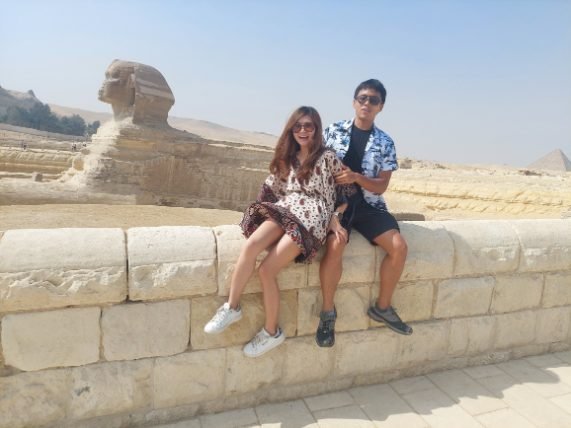
Day 1 Arrival at Cairo & Giza
Upon at arrival Cairo International Airport, there are two things you need to do before embarking on the adventure. First, you may need to purchase a visa to clear the customs. The visa is USD 25 per person available at the lefthand side exchange counters before the passport check and it only accepts cash. However, please note that some countries may not require a visa. For example, I purchased the visa but turned out I did not need it. Luckily, I can still take the visa and get refunded at the exchange counter.
Second, you may want to exchange some local currencies here. First, the rate is the same as what is shown on Google. Unlike in other Asian and European Countries, exchanging is illegal out of banks or ATMs in city centers. In that, exchanging at the airport would give you better convenience. Not to forget the “tipping culture” in Egypt, so it is always better to have some local currencies (ideally some notes below 100 EGP).
As for how much you need, it would depend on your expected spending. However, some points for you to consider:
1. All the entrance fees for temples, Museum, and landmarks accept card only (entrance fee shall account for a major portion of your expenses)
2. Hotel expenses, cruise official tipping, or even other tipping (although it’s best to be done in EGP) can be paid with either USD, EUR, or EGP according to Google rates.
3. Local food or most local souvenir shops mostly accept EGP but paying USD is also fine
I exchanged USD 250 equivalent EGP for 2 persons and I find it more than sufficient throughout my adventure.
** You are also advised to bring some small notes of USD in case you need them.

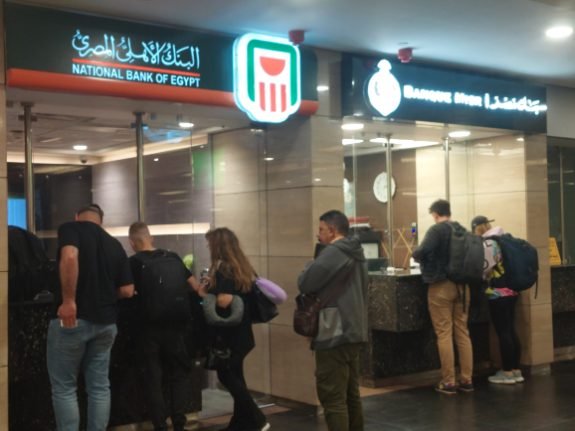
Half Day Pyramid Adventure
On the first day, we will be focusing on the Pyramids (your reason for coming to Egypt right?). You can either take an Uber to Giza or use local tours. If you would like to just cover the Great Pyramid of Giza(the big three ones), then there is not much difference between traveling by yourself or local tour.
On the first day, I chose to take a local tour via Viator. It covers the Pyramids at Giza ( the place for the iconic three pyramids namely Khufu, Menkaure, and Khafre) and Sakkara & Dahshur (the ancient capital city, Memphis with Pyramids like Bent, Red, and Step).
Taking a local tour is a good idea if you want to cover all the Pyramids within half a day. However, you may have limited time for photos or exploration of each icon. For example, despite taking the local tour, I had to visit the Giza pyramids again to take photos of the Sphinx and Great Pyramids.

More About Pyramids Part: The Pyramids At Giza
A photo of the Great Sphinx with the three pyramids at the backdrop is the most iconic picture of Egypt. This is what you can experience at Giza (the entrance fee is 540 EGP (~ 11.2 USD) for visiting the pyramids, the complex nearby, and the Sphinx) in 2024 March.
To know more about the three Pyramids and the Great Sphinx, you can take a look at the below facts.
Khufu (or Cheops): The Great Pyramid of Khufu is the largest pyramid among the three. It is the largest pyramid in Egypt. Khufu’s pyramid was built during the 26th century BCE and stands approximately 146.6 meters (481 feet) tall.
Khafre (or Chephren): The Pyramid of Khafre is the second-largest pyramid of the three. It is slightly smaller than Khufu’s pyramid but is often perceived as larger due to its elevated location on the Giza Plateau. Khafre’s pyramid was constructed during the 26th century BCE and has a height of about 136.4 meters (448 feet).
Menkaure (or Mycerinus): The Pyramid of Menkaure is the smallest among the three pyramids. It is significantly smaller in size compared to both Khufu and Khafre’s pyramids. Menkaure’s pyramid was built during the 26th century BCE and stands approximately 65.5 meters (215 feet) tall.
Great Sphinx: The statue is approximately 20 meters (66 feet) tall and 73 meters (240 feet) long built around 2,500 BCE during the Old Kingdom pyramid. The lion’s body and human head are believed to represent Pharaoh Khafre guarding the necropolis and pyramids.

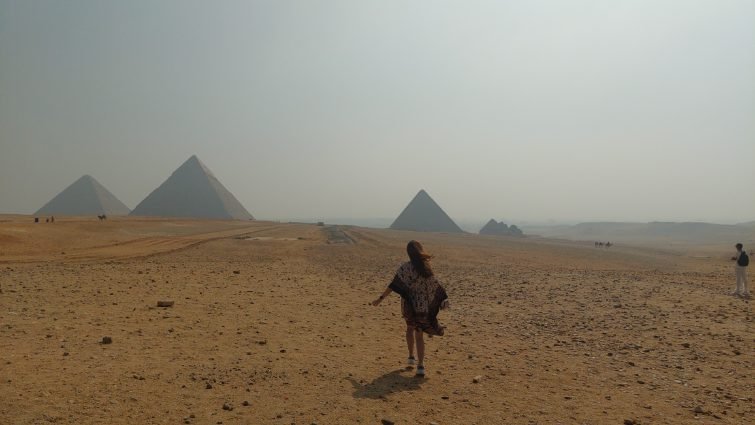

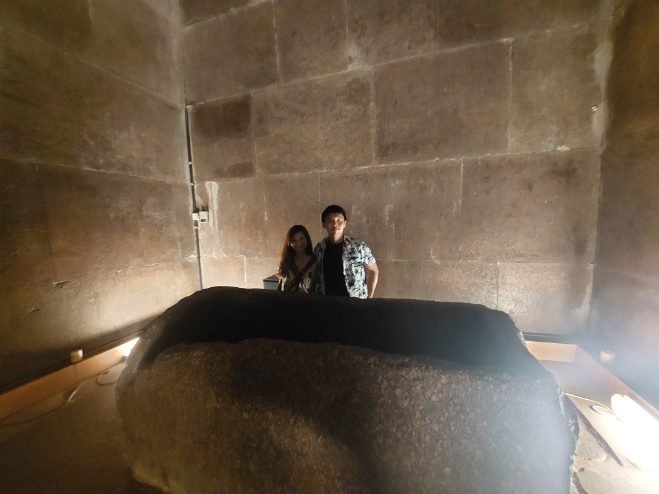

More About Pyramids Part 2: The Pyramids At Sakkara & Dahsur
Around 40-minute drive from the Giza Pyramids, you will reach the Sakkara (Memphis) area. Memphis City founded in 3100 BC was the first capital of Egypt. There is a museum in the old Memphis city with a gigantic statue for Ramses II. Furthermore, it is also famous for the Step Pyramid (aka Sakkara Pyramid or Djoser Pyramid).
Around a 20-minute drive from the Step Pyramid, you will arrive at Dahshur. Bent Pyramid and Red Pyramid are the most famous Pyramids there. The Bent Pyramid was built around 2,600 BC, it rises from the desert at a 54-degree inclination with 43 degrees at the upper part, making it a ‘bent’ appearance. The Red Pyramid is the largest in the area and got its name due to its red limestones.
Noting that most of the entrances to the pyramids are free in this area. There is a ruined pyramid called Userkaf near the Step Pyramid. Inside there, you can see clear hieroglyphics inside.
Despite the distance from Giza, the landmarks in Sakkara and Dashur area are worth visiting.
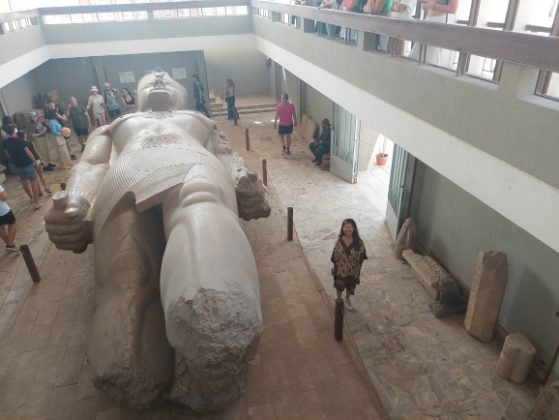
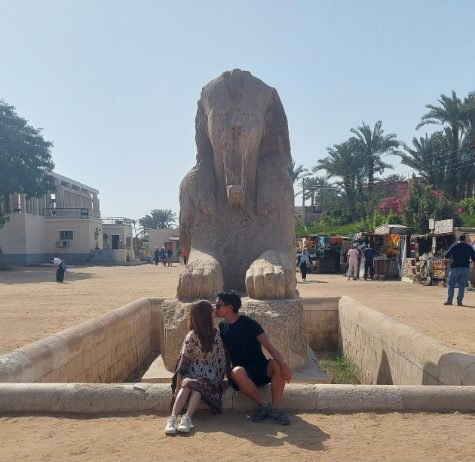

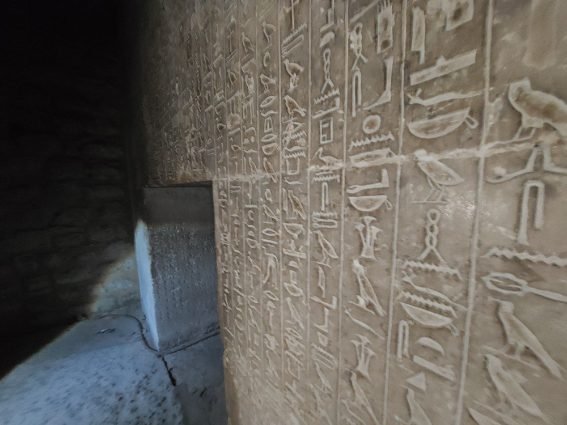


Pyramid Night Show
Heading back to Giza, you can take a rest at your hotel/hostel. The hostels at Giza are very affordable and best-valued ranging from USD 10 – 30 per night. Most of them have a rooftop for the Great Pyramids. You can choose the ones that are closer to the entrance of Great Pyramids for better views like Great Pyramid Inn and Solima Pyramid View.
For dinner, I recommend you to go to the Pizza Hut there. This is probably the best Pizza Hut in the world where you can enjoy pizza (and the price is a lot cheaper than many Countries) on the rooftop with a view of the Sphinx plus the Great Pyramids. There you can take perfect sunset pictures of the pyramids and enjoy the light show (daily at around 7:30 PM) for free.
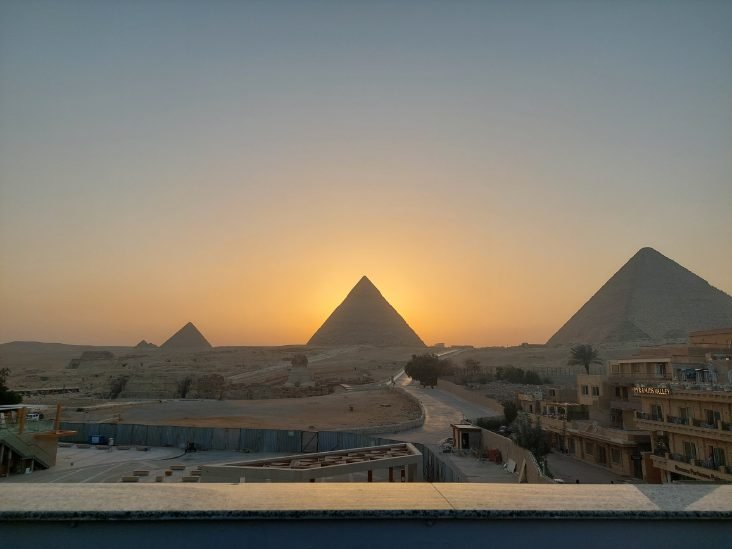

Day 2 Visiting Cairo City
On day 2, we will start with breakfast at the rooftop of the hostel, enjoying both local dishes and the pyramid views. Remember to choose a hostel with breakfast and a rooftop as mentioned earlier.
After a hearty breakfast, we will be spending the rest of the day at Cairo city center before taking the night train to Aswan. For the luggage, I chose to leave it at the hostel where I will be staying on the final day (please communicate with them before doing so). Subsequently, I take it back from the hostel before taking the night train. Alternatively, you can also put it at your Giza hostel but you may need another ride Uber to take it back.
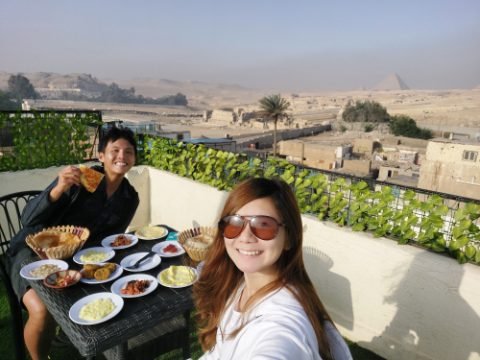
The Egyptian Museum in Cairo (not the Grand One)
There are multiple Museums in Cairo. The Egyptian Museum is the one that you must see. The entrance fee is 300 EGP (~6 USD). Not only it is a lot cheaper than the Grand Egyptian Museum (entrance fee is 1,000 EGP ~ 20 USD), but it also has more artifacts.
Nestled in the heart of Cairo, Egypt, the Egyptian Museum has a vast collection of artifacts and treasures, this iconic institution for visitors. It houses 120,000 artifacts spanning several millennia, such as remarkable achievements, beliefs, and cultural heritage of the ancient Egyptians. From intricately carved statues and priceless jewelry to meticulously preserved mummies and stunning works of art, you will find all you need to know about ancient Egypt here.
The museum’s most renowned exhibit is undoubtedly the Tutankhamun collection, which includes the world-famous golden mask of the young pharaoh. There is always a long queue in the museum to enter the session.
With the depth of information, you will need at least 2 hours for the museum.

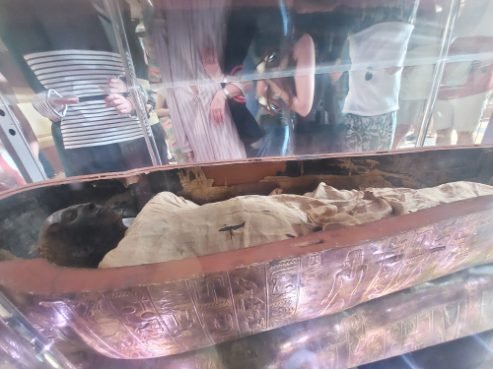
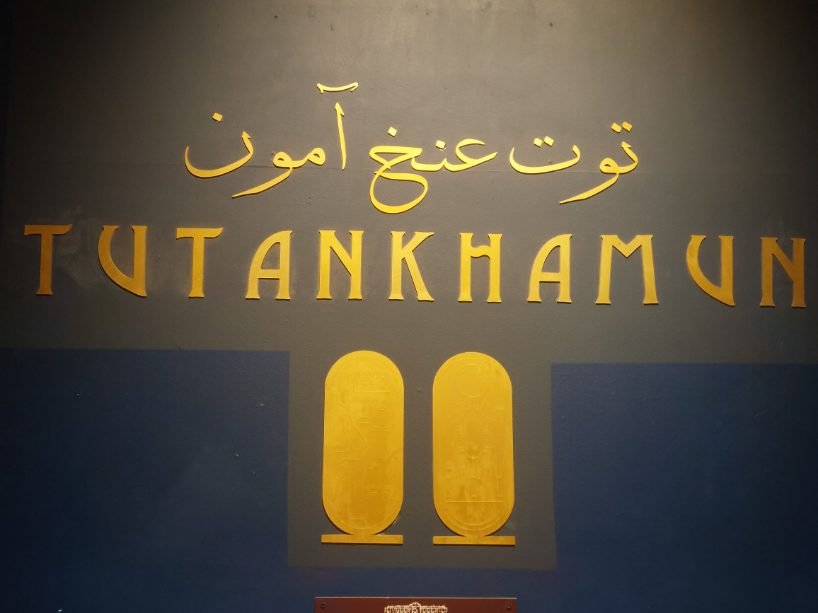

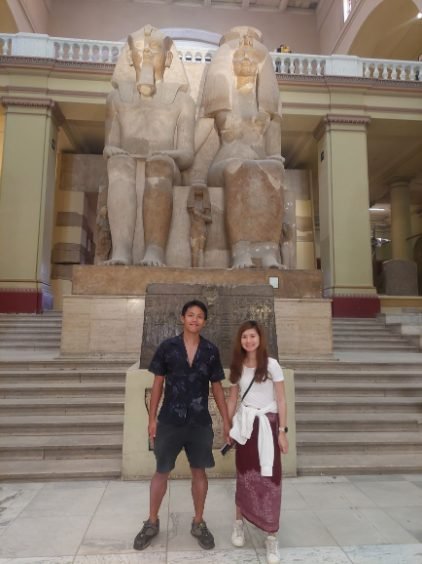
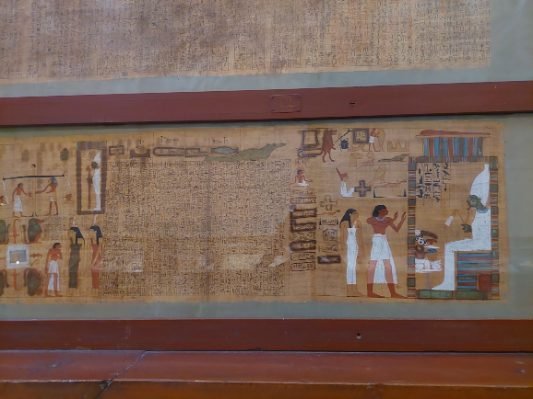
Khan el-Khalili Bazaar (the souvenir paradise)
After the museum visit, the Khan El-Khalili Bazaar is our next stop. The bazaar is an iconic marketplace in Cairo reputable for its commercial and cultural life. Although it has a long history dating back to the 14th Century during the Mamul era, to us it is the best place for souvenirs and sightseeing.
Amongst the maze of narrow streets and bustling squares, there are a lot of local shops selling local products. As a tourist, remember to bargain for whatever you eye on.
Looking for the best-valued souvenirs, I recommend you to visit “Jordi bazar shop”. It is located on the 2nd floor of a building complex in the Bazaar. There you will find fixed-price souvenirs like decorations, t-shirts, and other items, selling for at least 20% of the quoted price elsewhere. This is so far the cheapest souvenir shop I have come across globally.
You can also have your lunch here before the overnight train.

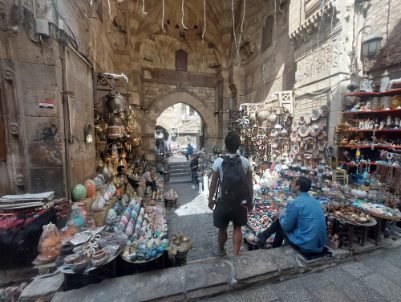
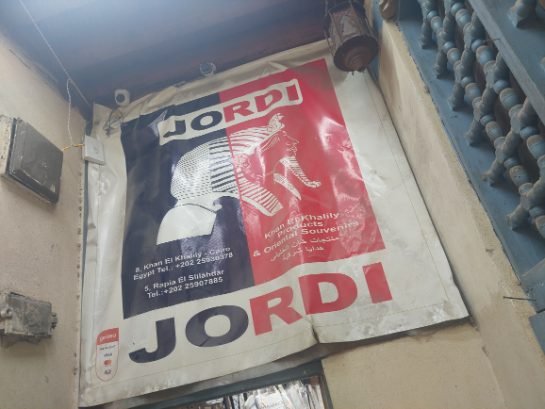

Abela Sleeping Train To Aswan
Grabbing back the luggage, we will be heading to the Abela sleeping train to Aswan via Uber. Experiencing the overnight train is one of the popular choices for tourists. Not only does it provide a famous view of the journey, it also saves you a night’s accommodation and is cheaper than taking a flight.
There are usually multiple trains to Aswan each day. A double cabin is around USD 90 per person. To ensure availability, you shall book the ticket in advance at Abela’s official website.
Noting that locating the right platform could take time, so you should arrive at the station at least 1 hour before departure.

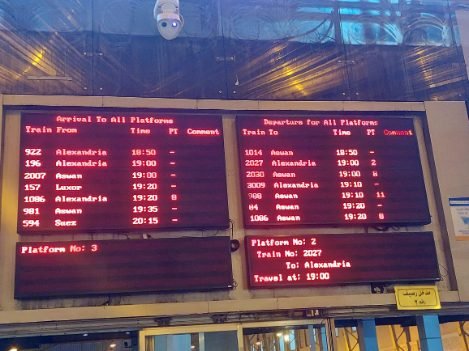




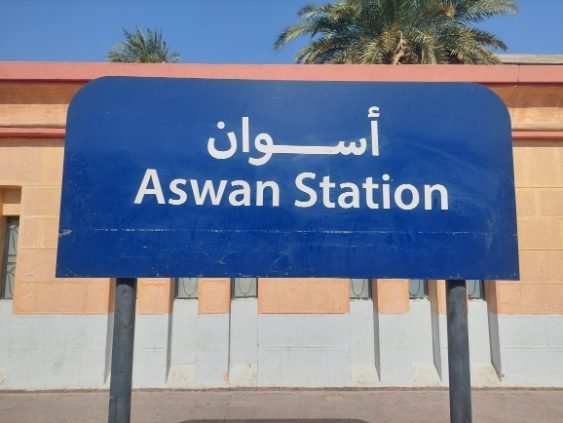
Day 3 Nile Cruise Tour Begins
Arriving at Aswan station at around 8:35 am, we will embark next chapter of our adventure. This is the point where we start to take a 4-day 3-night Nile Cruise.
More about Nile Cruise
Nile Cruise is one of the most common options for tourists exploring the landmarks from Aswan to Luxor. First, the Nile River itself is a famous icon and a famous murder novel called “Death on the Nile” by Agatha Christine. Second, most of the temples are located near the River, and using the cruise would save you a lot of hassles.
For expectation management, the cruises are not the 5-star gigantic cruises with gyms, casinos, and other entertainments. However, most of them have very decent buffets (with good veggies and meat), a sundeck (with complimentary teatime), a small swimming pool, and comfortable rooms.
Although water and other beverages are not included, the price is very reasonable even on the cruise. As for other expenses, tipping is required for cruise tours, the one I took for 4 days and 3 nights costs USD 19 (all inclusive) for each of the persons.
Please note that the entrance fee to each landmark is not included. The total entrance fee is around USD 85 per person. You can pay EGP, USD, or EUR to your guide. Overall, speaking I find the tour experience pretty nice and no one would push you for tips other than the official USD 19.
There are a lot of cruise tours available online. I chose the 4-day 3 3-night one on Viator (Aswan to Luxor: Nile River 4-Day Cruise with Abu Simbel 2024 – Viator )which fit perfectly for the one-week Egypt travel plan. To ensure a satisfactory experience, you should choose the one from reputable online agents with a good number of comments. Because of that, your comment could serve as good leverage for the local tour guides.
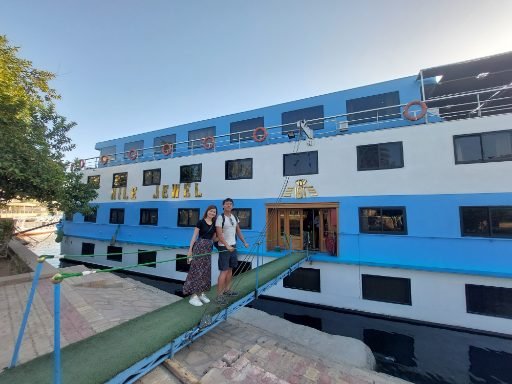

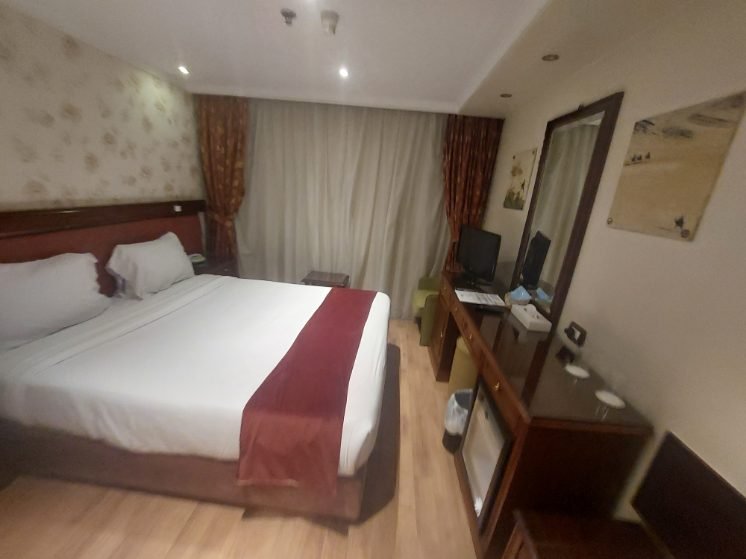
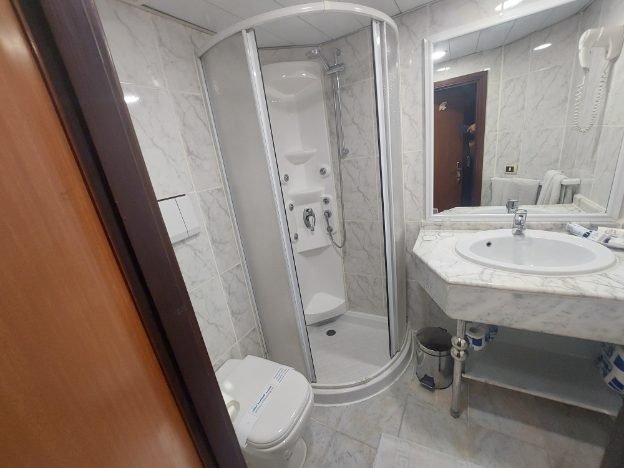


Aswan High Dam
After settling down on the cruise and enjoying the first buffet lunch, you will arrive at the first icon – Aswan High Dam. Stretching over 3,800 meters with an impressive height of 111 meters, the high dam has played an important role in generating hydroelectric power since 1970. However, the construction also led to the flooding of multiple ancient landmarks such as the Philae temple and the most famous Abu Simbel temples. Subsequently, it led to a series of emergent rescue projects of the UN to relocate and restore the heritages.

Philae Temple
Philae temple is the first temple you will see during the tour. Dedicated to the goddess Isis, this temple is located on an isolated island near Agilikia Island. The original location of the temple was on Philae island but has to be relocated due to the flooding after the construction of the high dam.
In the temple, you will see a symphony of stunning hieroglyphics and majestic columns. The temple’s architecture reflects the mastery of ancient Egyptians and the glorious ancient times. As the first temple in our journey, you will find a super amazing.
Just be aware that do not trust any security guard who tries to introduce you to special scenes on site. As they are just trying to ask for tips by doing so.
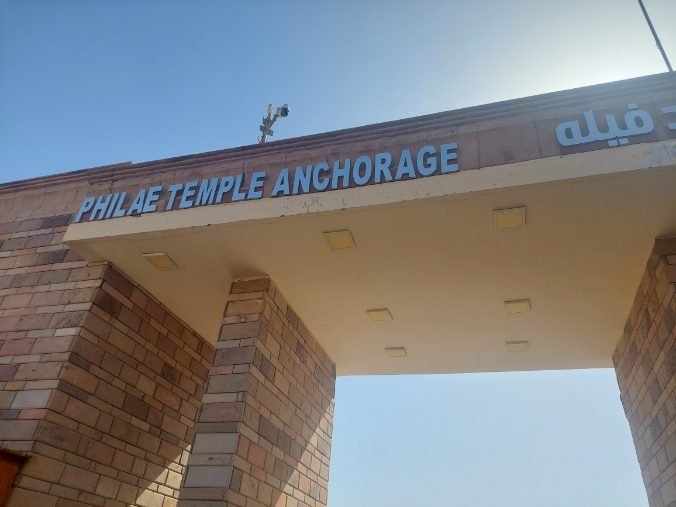
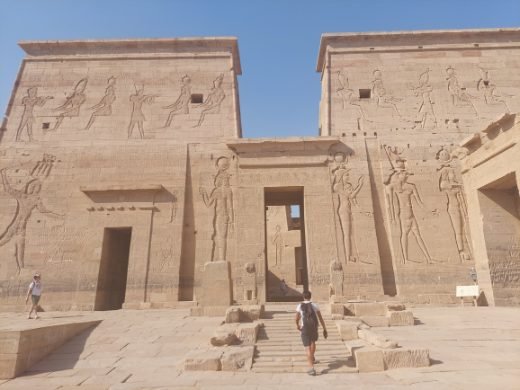

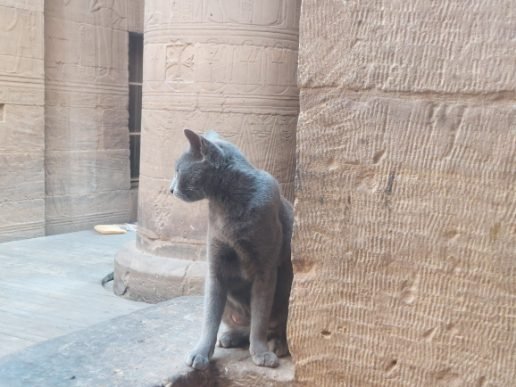
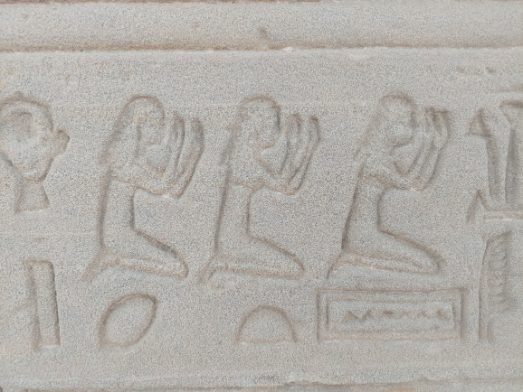
Nebuian Village
It is usually an optional item for cruise tours. If you take it you will need to pay an extra of 25 USD to visit the Nebuian Village. The tour includes a visit to the village, the shops nearby, and a chance to swim in the Nile River.
While Nubian culture is one of the ancient heritage in Africa, some find this item too commercial and even regard that as a tourist trap. I did not opt for going there but I would recommend you to check a similar tour for this item to decide.
Nubian Village by Motorboat In Aswan 2024 (viator.com)
If you are too exhausted, you can stay on the cruise and wait for the dinner. Remember you need to wake up around 5 am each day for the itinerary during the cruise. So it is not a bad idea to have some rest in between.
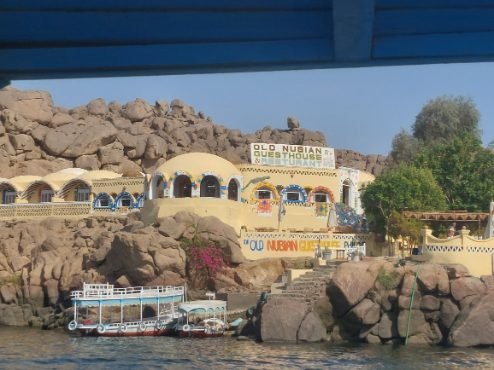
Day 4 Abu Simbel Temple, Kom Ombo Temple
Day 4 is the second day of our cruise tour. Today the main character would be visiting Abu Simbel Temple. We followed by lunch, a visit to Kom Ombo Temple, and sailing to Edfo.
Abu Simbel Temple
Carved into the solid rock cliff during the time of Ramses II, Abu Simbel is the second most famous landmark in Egypt after the Great Pyramids. The Abu Simbel Temple comprises two main structures: the Great Temple and the smaller Temple of Hathor. The Great Temple is a colossal masterpiece, featuring four colossal statues of Ramses II seated on his throne, each measuring over 20 meters in height. These imposing figures guard the entrance, exuding a sense of power and authority that has withstood the test of time.
The front of the Great Temple is the most popular spot for taking IG photos. If it’s too crowded, you may try to take it from the corner or a slight distance behind the wall on the right-hand side. Inside the Great Temple, you will see the remarkable chambers adorned with intricate carvings and colorful murals. At the end of the central corridor, you will find the innermost sanctuary houses statues of the gods Ptah, Amun, and Re-Horakhty, symbolizing the sun god Ra in his different forms. It is also famous for its solar festival each year.
Adjacent to the Great Temple is the Temple of Hathor, dedicated to the goddess of love and joy. This smaller but equally captivating structure features six statues of Ramses II and his beloved wife, Queen Nefertari. It’s not as huge as the Great Temple but you should spare 30 minutes or so to check it out. Again there are a lot of beautifully preserved hieroglyphics and ornate columns inside.
Apart from the structures, Abu Simbel Temple is also famous for its relocation project due to the construction of the high dam in the 1970s. It took international efforts to relocate this temple to its current location.
At 4:30 am, you will need to get on the bus to the Abu Simbel and it is a 3.5-hour ride (and another 3.5 hours back). Packed breakfast will be provided but you should also bring enough water and sunscreen before going there.
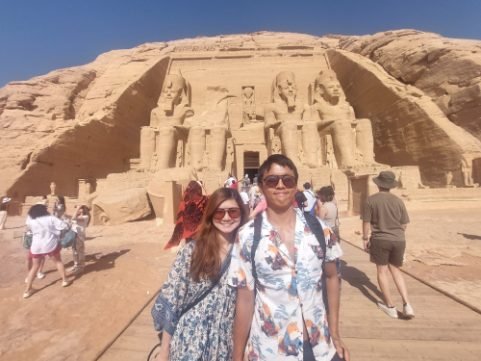
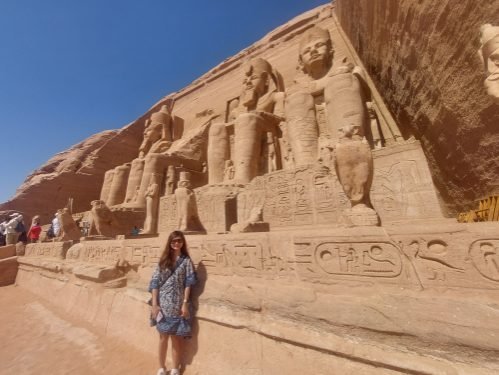
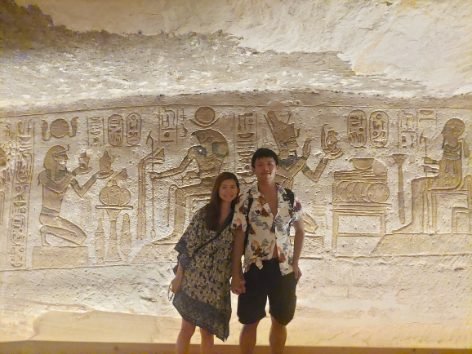
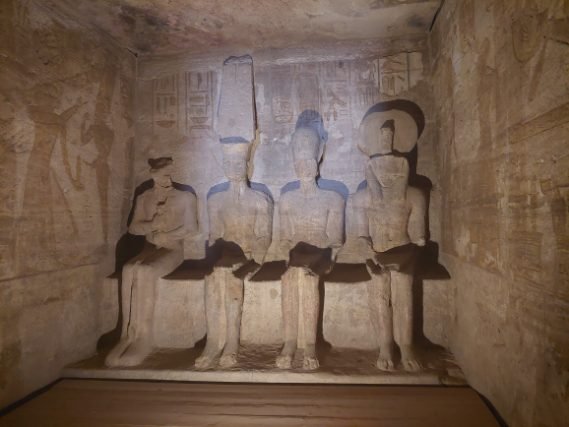
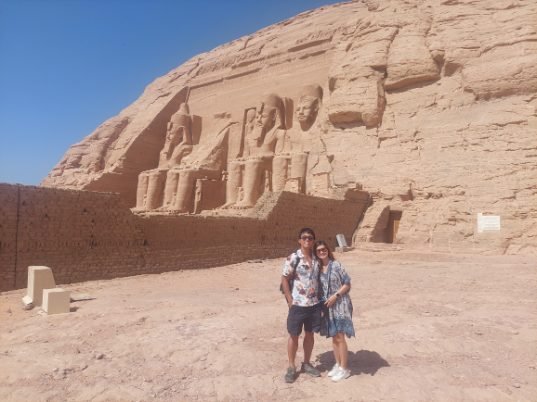
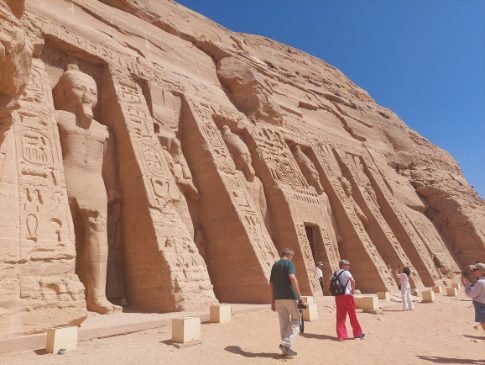
Temple of Kom Ombo
After the long journey to Abu Simbel in the morning, you will get back to the cruise for lunch at around 1:30 PM. After the buffet lunch, you will then visit the Kom Ombo Temple (the dual temple of Sobek the crocodile god, and Horus) at around 4 pm.
The Temple has a unique design, consisting of two symmetrical sections mirroring each other along a central axis. One side is dedicated to the crocodile-headed god Sobek, associated with fertility and protection. The other is dedicated to the falcon-headed god Horus, the embodiment of divine kingship and sky symbolism.
Apart from the carved columns and hieroglyphics with the stories of both gods, there is a crocodile museum inside the Temple. There you will find showcases of mummified crocodiles.
You will be leaving the Temple around 6 pm, so you will also have a chance to enjoy the night scene of it.


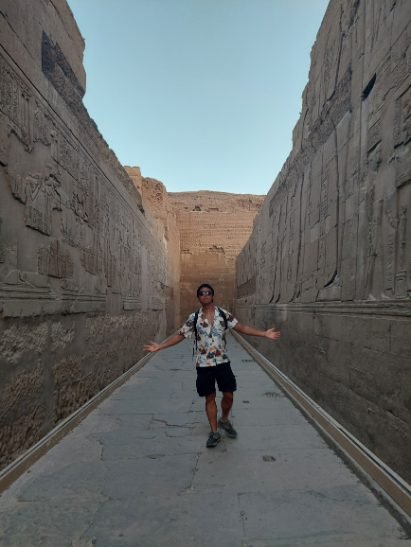

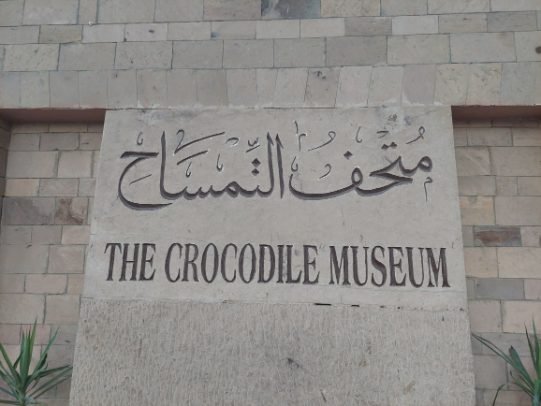
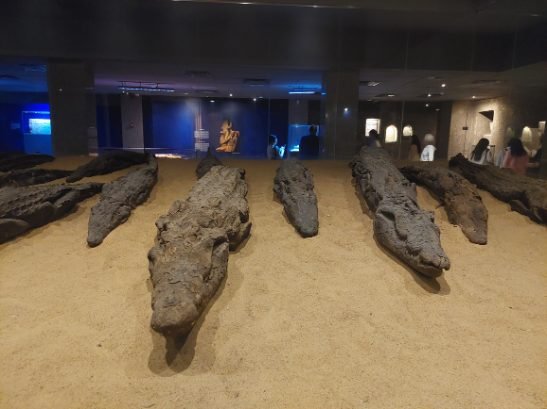
After the visit, you will be back for an Egyptian-themed buffet dinner, while the ship will be heading to Edfu overnight.
Day 5 Horus Temple, Sailing to Luxor, Luxor Temple
On Day 5 which is your third day on the cruise, it will be a visit to another two temples. While the two temples have their feature, the third day is the best day for chilling. Today you can have your buffet breakfast on a cruise before heading to Horus Temple.
Horus Temple (aka Edfu Temple)
Horus Temple (aka Edfu Temple) is dedicated to the falcon-headed god Horus in ancient Egyptian mythology. The colossal statue of Horus in falcon form at the front door is the key feature of the Temple. Inside the temple, you will find a lot of intricate carvings including the battle between Horus and his arch-nemesis Seth.
Similar to other temples the detailed hieroglyphics and walls are great backdrops for your IG photos.




Sailing to Luxor (Passing by Esna Lock)
After the visit to Horus Temple, you will go back to the cruise for the lunch buffet. Meanwhile, the cruise will start sailing to Luxor. The sailing is around 3 hours. With that, you now have sufficient time to chill out at the sundeck, enjoy the swimming pool, and also have an afternoon tea with cookies. During the journey, you will also pass by the Esna Lock which is the control point to traverse the cruise between Upper Nile and Lower Nile.

Luxor Temple
Arriving in Luxor, the Luxor Temple is the first icon. As one of the most representable temples built in the New Kingdom period, the Luxor Temple served as a focal point for religious rituals, grand processions, and celebrations. So unlike the temples that we visited earlier, it is a huge temple with multiple sections.
Before getting inside the temple, you shall first visit Sphinx Avenue opposite the front door. It used to be a sacred path between Luxor and Karnak Temple (which we will visit tomorrow). There are hundreds of Sphinx statues lining both sides of the avenue. So do not forget to take a nice photo here.
Getting into the Luxor Temple, you will find several colossal statues (mainly Ramesses II). Again you will see different hieroglyphics on the wall depicting the stories of Pharaohs. At the heart of the temple, there is an Inner Sanctuary dedicated to the god of Amun-Ra.
Ending the visit to Luxor Temple, take a good rest on the cruise after the dinner buffet. Because tomorrow will be the most exciting day for the cruise tour.




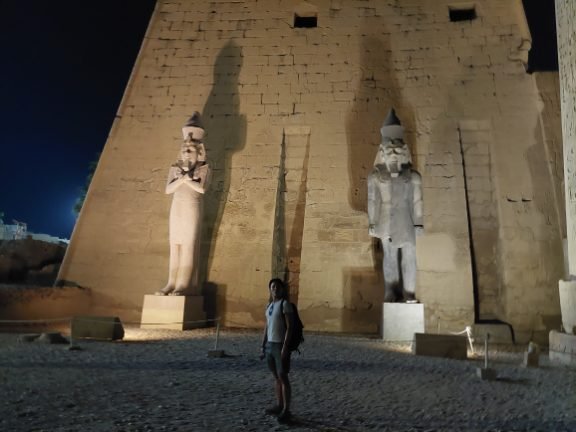
Day 6 Hot Air Balloon at Colossi of Memnon, Hatshepsut Temple, Valley of the Kings, Karnak Temple, Flight / Train (from Luxor to Cairo)
Day 6 is our last day on the cruise and it is also the busiest day. It includes a ~ 40-minute air balloon, the Valley of the Kings, and some more temples…
Hot Air Ballon at Colossi of Memnon
Starting at 5 am, you will be heading to the Colossi of Memnon for the hot air balloon ride. The hot air balloon will last around 40 minutes flying over the west bank of Luxor. During the ride, you can enjoy the ariel view of multiple famous landmarks including the Valley of the Kings. Naturally, you can take as many photos as you want but you should be aware of dropping your phone.
The balloon is operated by a licensed pilot and you will even have a certificate after the ride.



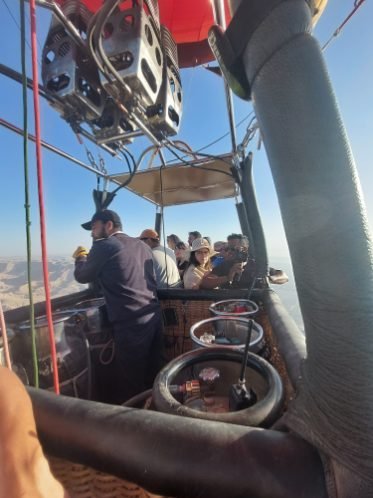
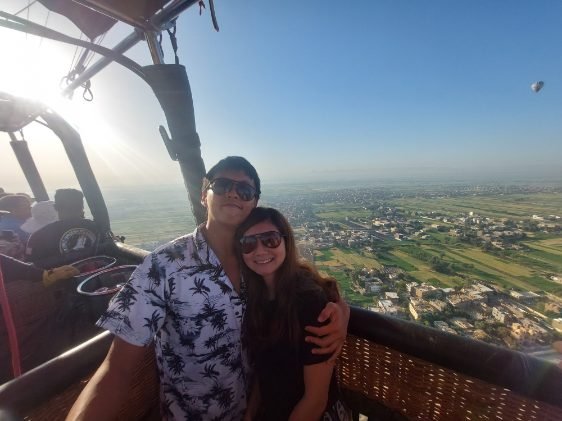



Valley of the Kings
After the air balloon ride, we will head to the next landmark – the Valley of the Kings. So far we have visited pyramids, multiple temples, and a museum depicting different Egyptian artifacts. I have to say I get a bit bored about temples at this point.
The Valley of the Kings just came in time. Chosen based on the remote location, the place is the burial site for pharaohs between 16th – 11th centuries BCE. It has over sixty tombs constructed during that time. As a visitor, you can enter the pharaoh’s tomb itself. The tomb is assigned based on the pharaoh’s name and excavation number.
The entrance ticket (600 EGP or ~ 12 USD) includes three selections of tombs opened on that. Despite being on a group tour, you can still select your own choices (that means you will have to walk away from the group and explore yourself).



At the entrance point, you will also need to decide whether to purchase the entrance to extra tombs namely Sety I (1,800 EGP or ~ 37 USD), Tutankhamun (500 EGP or ~ 10 USD), or Ramesses V & VI (180 EGP or ~ 3.7 USD).
I highly recommend you to go for the Remesses V & VI which is very well decorated and best-valued at its price. Additionally, you could also buy a ticket to Tutankhamun’s tomb if you want to see the mummified Tutankhamun. Warning despite their fame, Tutankhamun’s tomb is the smallest and you can finish in 5 minutes. As for Sety I, I did not go due to its content versus the price.
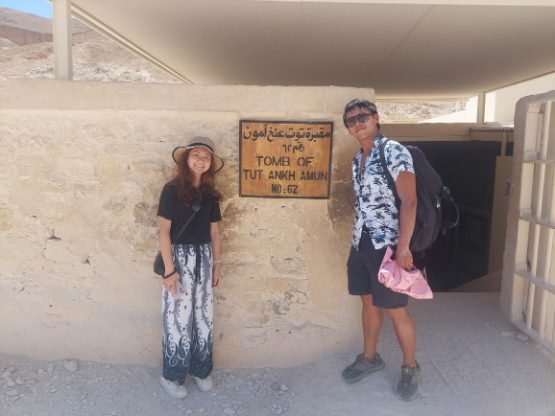


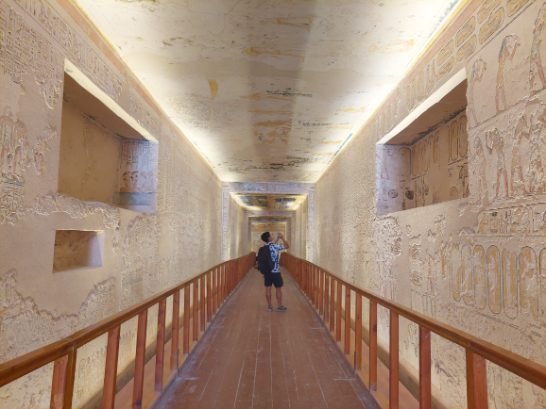


For the three free options, I picked the below:
KV 11 The Ramesses III – very well decorated after Ramesses V & VI, but the glass protector would hinder photo taking. The corridor is a good spot for taking IG photos.
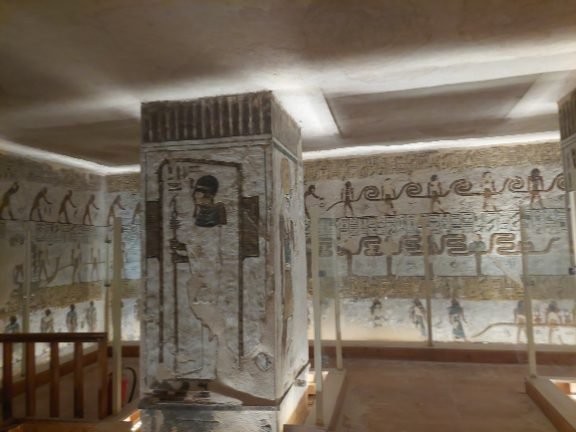


KV 2 Rameses IV – very well decorated after Ramesses V & VI without any glass protector. The corridor is a good spot for taking IG photos.
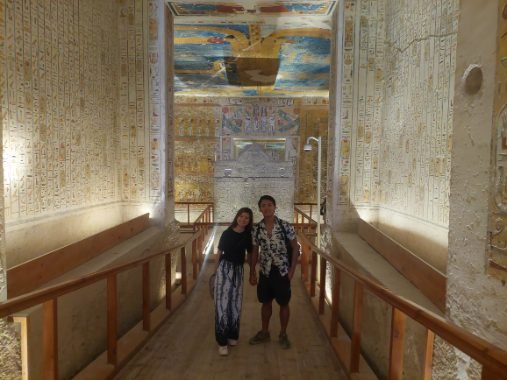

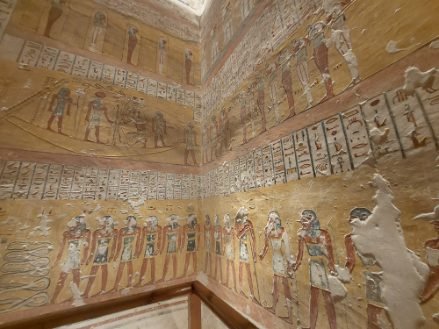
KV 14 Tausert / Setnakht – said to be one of the largest tombs but the accessible area is quite limited.
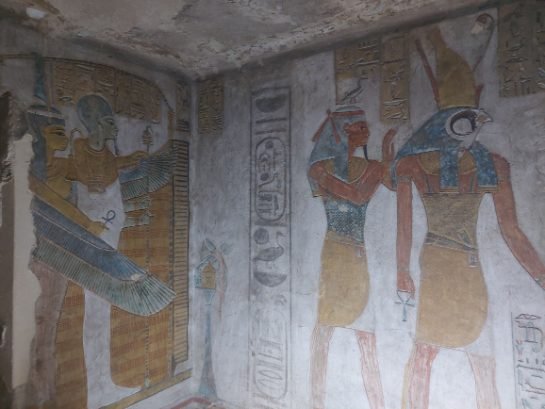
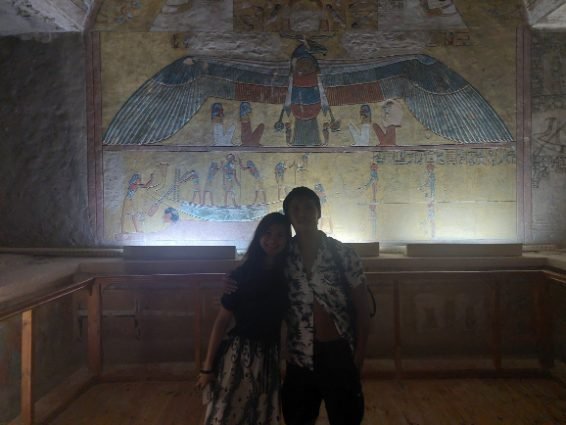
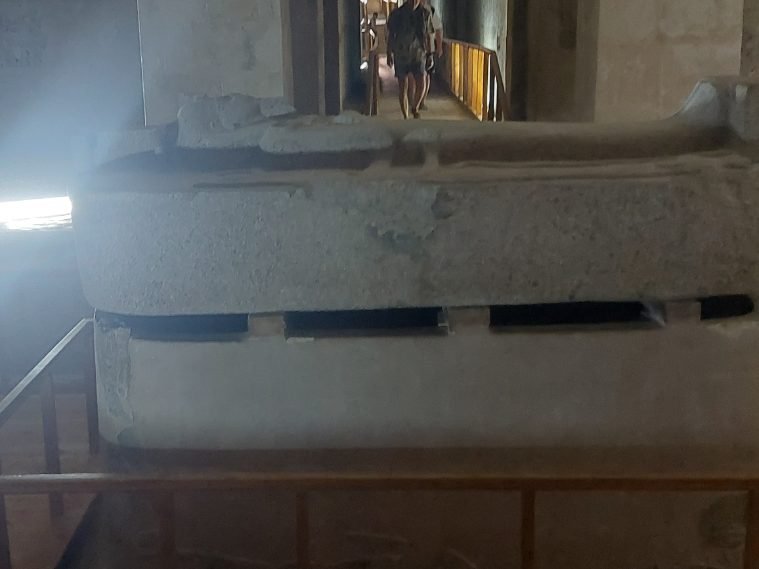
For details, you may visit the below website but you can also check online for the tomb you want to visit.
Best Tombs to Visit in the Valley of the Kings, Luxor, Egypt – Earth Trekkers
There will be a lot of walking for the Valley of the Kings. The distance in between tombs could be long (depending on your choice). So please bring enough water, sunscreen and an anti-UV umbrella.
Temple of Hatshepsut
Built in the 15th century BCE during the New Kingdom time, this temple is dedicated to Pharaoh Hatshepsut. It serves as her mortuary temple, reflecting a unique architectural style during that time. There are two floors at the temple with the entrance flanked by pharaoh statues. The upper level is the sanctuary area for Hathor Chapel.
Again it’s a good chance for IG photo taking if you have not flown up to temples yet (after all we visited a lot during these days). Before heading to the last temple, yes another one. The tour would usually include an optional lunch at 8 USD. Although it’s not worth the price, we decided to take it given there is no better option.
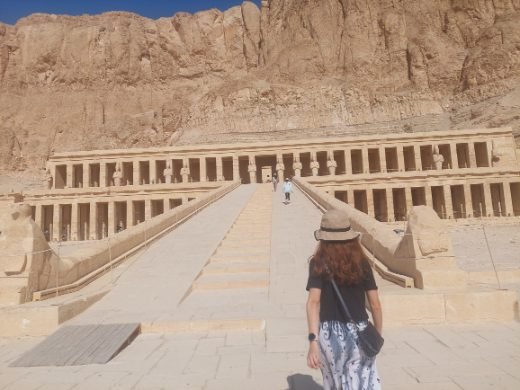

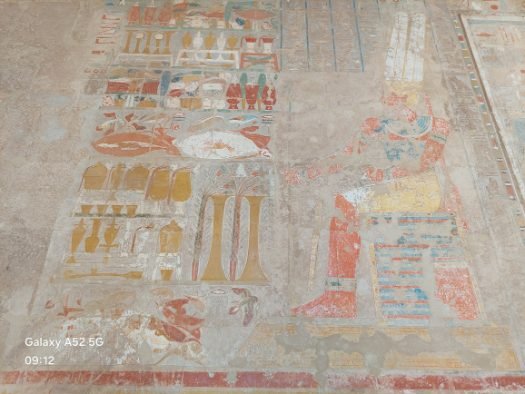
Karnak Temple
Well as the last stop of the cruise tour, we arrive at the Karnak Temple. It is one of the largest temples in Egypt with over 100 hectares. Dating back over 4,000 years, Karnak was not just a single temple but a vast complex consisting of numerous temples, shrines, pylons, and obelisks.
So you can imagine there is quite a lot to walk around here. The whole complex includes several temples including the Temple of Khonsu, the Temple of Ptah, and the Temple of Montu.
Well after the numerous temples these days, I believe you would probably only grab the final chance to take some last photos of Luxor.
After the visit, the tour would usually include a transfer to the airport, train station, or hotel. For our one week Egypt travel plan, we chose to head to the airport directly for a flight back to Cairo.






Day 7 final day in Cairo
Today is the final day for our one week Egypt travel plan. I took this chance to visit the Great Pyramid on my own again and spent 3 hours there photoing. After that, I bought a lot of great souvenirs at the Khan el-Khalili Bazaar before ending the journey.
Depending on your preference, you can also grab this time to visit other landmarks such as the Mosque-Madrasa of Sultan Hassan, The Hanging Church, or The Cave Church (which is a bit far). All those places are accessible via Uber.
So we have concluded our one week Egypt travel plan. Let’s take a look at other points before your departure.




How much does it cost for the one week Egypt travel plan?
Excluding the air ticket, it takes around USD 800 for the one week journey. It is not a luxurious tour but quite a best-valued one with cruise, uber, and a lot of souvenirs bought.
I included the main items for your reference
| Budget for one week Egypt travel plan | USD per person |
| Nile Cruise Fee | 351 |
| Entrance Fee includes Pyramids, the Egyptian Museum, and the landmarks visited during the Nile Cruise | 110 |
| Abela Sleeping train Cairo to Aswan | 90 |
| Flight Luxor to Cairo | 85 |
| Food at restaurants, beverage & Uber | 50 |
| Tipping (including the USD 19 for the cruise) | 35 |
| Accommodation Cost for Day 1 & 6 | 30 |
| Giza half-day tour | 25 |
| Souvenirs | 20 |
| Total | USD 796 |

Which price I should refer to?
As you may have noticed the listed price of the entrance fee changes a lot due to the fluctuation of currency. For example in 2024 March, EGP depreciates for ~ 50% against USD. Most of the entrance fees would adjust according to the rate change. So for budgeting, you should always refer to the price in USD when researching online.
USD or EGP?
As mentioned above, EGP is the currency used in Egypt. While USD is also acceptable in most of the shops at Google rate. You shall have some EGP for tipping and small changes. You can also keep a 1 EGP coin which has Tutankhamun in front as a souvenir.

You also need to note that all of the entrance fees in landmarks accept cards only. However, the USD 85 you pay during the cruise tour is in cash. I have checked the price is the same as you pay at the entrance of each site. In that way, the cruise company makes some money by buying tickets on wholesales and you save the queuing time.
A final word about Do and don’ts in Egypt
As covered earlier, Egypt is one of the most special travel experiences you can have. Our one week Egypt travel plan solely focuses on the exclusive ancient civilization of the place. You may hear a lot of negative news about the local aggressive culture. For that, I assure you that it is in general true but it is improving. For example, the Uber is Cairo is in general okay (8 out of 10 times) and the cruise tour is a lot decent than I expected.
Of course, to protect yourself, you should do your homework beforehand.
Wish you had a wonderful 7 days in Egypt. Please do leave me a comment on your journey.
